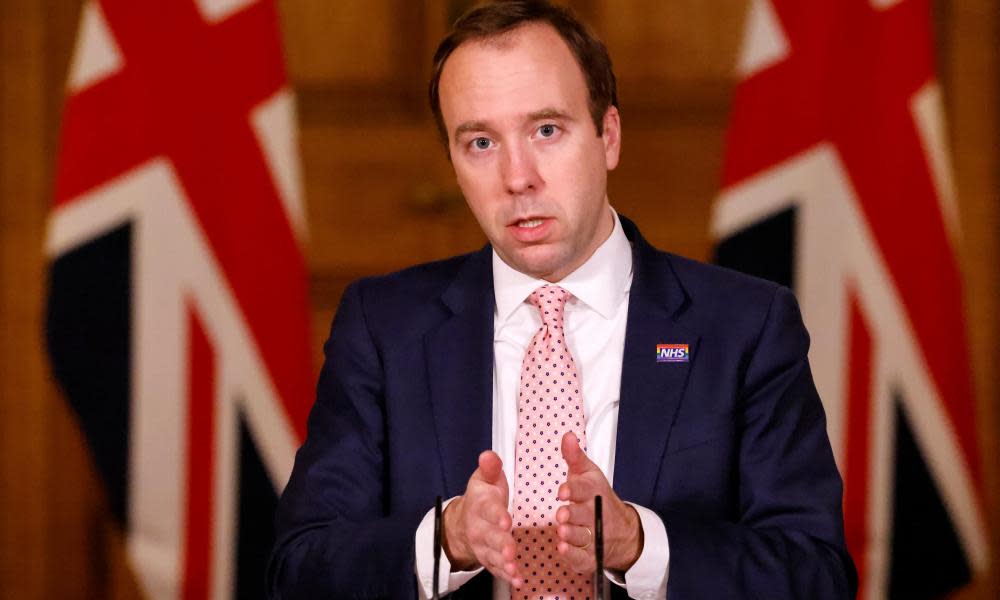The NHS test-and-trace failings that contributed to UK’s 2020 Covid Christmas

As Britain approached its first Christmas with Covid, Matt Hancock was typically tiggerish, even as a worrying new variant bubbled up in Kent.
“The finish line is in sight,” the health secretary told the nation from the Downing Street lectern on 10 December 2020. “And I know that, together, we can get there.”
It was wildly over-optimistic, not least because Hancock had spent much of the rest of his Thursday teatime presentation warning about rising Covid cases among school-age children in London, Kent and Essex – caused by what would become known as the Kent or Alpha variant.
Vaccines were only in their first days, so defences were limited. Earlier that week Hancock appeared on ITV’s Good Morning Britain and appeared to wipe away a tear at the news William Shakespeare, 81, had become the second person to receive a vaccine. Testing would be key. As the Kent variant spread, Hancock sent mobile swabbing units to hotspots and warned of likely rising cases among more vulnerable people. As Hancock spoke, Britain was on the brink of its most deadly viral wave. From the start of December to the end of February more than 63,000 people died with Covid.
Meanwhile Boris Johnson was trying to allow three households to mix at Christmas, saying to ban it would be “frankly inhuman”. He eventually tightened restrictions amid public clamour for caution just days before the holiday. It would later emerge that red wine was spilt on a Downing Street wall and on stationery supplies at one of several government social events that month.
Since October the public had been getting acquainted with the plastic paraphernalia of lateral flow tests which were increasingly widely distributed. Hancock knew the importance of NHS Test and Trace, a system that would cost £13.5bn in its first year. He ordered city-wide testing in Liverpool and new “mega labs” to more than double daily testing capacity to 1.1m.
“We can identify and isolate people who have Covid, including, crucially, the one in three people with Covid who don’t have any symptoms at all – but can nevertheless pass the infection on,” he had said at the end of November. And at another press conference a fortnight later he made the system sound remarkably effective: “Our contact tracing now reaches 86% of contacts, and that’s up from around 60% just a few weeks ago.”
But huge numbers of the tests were simply disappearing. MPs on the Public Accounts Committee (PAC) later found that by late May 2021, only 14% of the 691m tests distributed had been registered as used.
There was also a perhaps bigger problem: even if a lateral flow was positive, contact tracing only started after a confirmatory laboratory PCR test. This was a decision made by Hancock on the advice of Public Health England, based on concern about the accuracy of lateral flows, particularly when the prevalence of the virus was low.
One concern was that thousands of key workers needed to keep the country going through the second wave might have to go off work unnecessarily if there were too many false positives. But the effect was to delay infectious people from isolating themselves.
The Scientific Advisory Group on Emergencies had already concluded: “Any delay beyond 48-72 hours total before isolation of contacts results in a significant impact on R [speed of virus spread].” Forty-eight hours was “desirable”, the government advisers said, adding: “The sooner it is done the better.”
But only 54% of PCR results came back within 48 hours and a quarter took more than 72 hours, the PAC found. More widely there was growing concern about the effectiveness of NHST&T which paid £3.1bn to secure PCR laboratory capacity and £911m for contact tracing. The PAC would later conclude that in 2020–21 NHST&T used only a minority of the laboratory and contact centre capacity it paid for. To growing public disquiet an army of more than 2,000 test-and-trace consultants were also being paid £1,100 a day on average.
Inside the Department of Health and Social Care, concerns were raised in December that confirmatory PCR tests “may be harmful”. There were “public health risks to our policy”, according to the Covid inquiry submission by Dr Achim Wolf, a senior UK Test and Trace official. On Christmas Eve, Public Health England recommended lifting the requirement.
But it wasn’t until 27 January 2021 that it was lifted, and then only for some people. In the preceding month about 1.8m people tested positive for Covid, and on 6 January England entered its third national lockdown, with schools shut.
“Track and trace failed to halt the waves of infection,” said Jim Naismith, professor of structural biology, at the University of Oxford in October 2021. “This was clear in real time last year. Too small a proportion of contacts were identified and instructed to isolate in a timely manner. The Royal Society had quite early on shown that success depended on isolating a very high proportion of the contacts of infectious people within a very short time window.”

 Yahoo Movies
Yahoo Movies 
